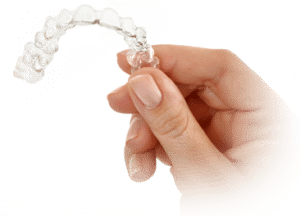How Does Invisalign Work? The Modern Path to Straight Teeth
Invisalign has gained immense popularity in recent years, and it’s not hard to see why. This innovative approach offers a clear, convenient, and comfortable way to achieve a straighter, more confident smile. But how does Invisalign work its wonders? Learn more about the science behind Invisalign to find out how long it takes for your teeth to move, any risks involved, whether there will be any pain, and how quickly your teeth will straighten.
Understanding Invisalign
Invisalign is a modern orthodontic treatment that offers a clear departure from traditional braces. Before delving into how Invisalign works, let’s grasp the fundamentals of what it is and how it differs from traditional braces.
What Is Invisalign?
Invisalign is an innovative approach to straightening teeth, employing clear, custom-made aligners instead of conventional metal braces. These aligners are designed for a comfortable and nearly invisible fit.
How Does Invisalign Differ from Traditional Braces?
The key distinctions between Invisalign and traditional braces include:
- Appearance: Invisalign aligners are discreet and barely noticeable, unlike the visible metal components of traditional braces.
- Comfort: Invisalign aligners are made of smooth, BPA-free plastic, offering a more comfortable experience compared to metal braces.
- Removability: Invisalign aligners are removable, allowing for easy eating, drinking, brushing, and flossing.
The Customization Process
Invisalign treatment starts with a personalized approach.
- Initial Assessment: An orthodontist assesses your dental condition, discusses your smile goals, and determines if Invisalign is suitable for you.
- Digital Imaging: Advanced technology, such as 3D imaging, creates a precise digital model of your teeth.
- Custom Aligners: Based on this digital model, custom aligners are designed to gently shift your teeth into their desired positions.
How Does Invisalign Work?
Step #1 – Initial Consultation
Begin your Invisalign journey with a consultation with an experienced orthodontist. Discuss your dental concerns, smile goals, and any questions you may have. Your orthodontist will assess your suitability for Invisalign.
Step #2 – Digital Impressions
Using advanced technology, including 3D imaging, your orthodontist will create a digital impression of your teeth. This precise digital model serves as the basis for your customized treatment plan.
Step #3 – Personalized Treatment Plan
Your orthodontist designs a personalized treatment plan that outlines the step-by-step movements of your teeth. This plan maps out the transformation of your smile from its current state to your desired outcome.
Step #4 – Custom Aligners
A set of custom-made Invisalign aligners is made using the computer model and treatment plan. The goal of these braces is to make sure that they fit your teeth perfectly.
Step #5 – Wearing the Aligners
You will receive a set of aligners, which you will wear for one to two weeks each, depending on your orthodontist’s guidance. You should wear the aligners for at least 20 to 22 hours a day, but you can take them out to eat, drink, brush, and floss.
Step #6 – Gradual Tooth Movement
Each set of aligners exerts gentle and controlled pressure on specific teeth, prompting them to move gradually. This process repeats as you progress through your aligner series, continually adjusting your teeth.
Step #7 – Regular Check-Ups
Throughout your Invisalign journey, you’ll have periodic check-ups with your orthodontist to monitor progress and receive new sets of aligners. These check-ups ensure that your treatment stays on track.
Step #8 – Achieving Your Desired Smile
Over time, with consistent wear and adjustments, your teeth will align according to your treatment plan. The result is a straighter and more confident smile.
Advantages of Invisalign
Invisalign has become a preferred choice for many individuals seeking orthodontic treatment, and it’s not solely because of its discreet appearance. Here are the various advantages that make Invisalign stand out as a modern orthodontic solution.
- Nearly Invisible Appearance: Invisalign aligners are virtually transparent, making them discreet and appealing to those concerned about the appearance of traditional braces.
- Comfortable Fit: Invisalign aligners are crafted from smooth, BPA-free plastic, providing a comfortable experience without the potential discomfort of metal brackets and wires.
- Removability: Invisalign aligners are removable, allowing you to enjoy meals without dietary restrictions. Brushing and flossing are more straightforward since the aligners can be taken out.
- Improved Oral Hygiene: Easier maintenance of oral hygiene as there are no fixed brackets and wires to navigate around. Reduced risk of plaque buildup and gum issues during treatment.
- Predictable Results: Advanced 3D imaging and treatment planning offer a highly predictable outcome. You can visualize the anticipated results before treatment begins.
- Reduced Treatment Time: In some cases, Invisalign may offer a shorter treatment duration compared to traditional braces. The exact timeline varies depending on individual needs.
- Fewer Orthodontic Visits: Invisalign often requires fewer in-office appointments compared to traditional braces, which can be more convenient for busy individuals.
- No Dietary Restrictions: Enjoy your favorite foods without worrying about damaging wires or brackets. Simply remove your aligners before meals and put them back in afterward.
- Minimal Impact on Lifestyle: Continue your daily activities, sports, and social interactions with ease during Invisalign treatment. The aligners are designed to fit seamlessly into your lifestyle.
- Suitable for Various Cases: Invisalign can address a wide range of orthodontic issues, including mild to moderate misalignments and crowding.
How Fast Do Teeth Move with Invisalign?
The speed at which Invisalign corrects misaligned teeth varies from person to person and depends on factors such as the complexity of your case, compliance with aligner wear instructions, and the number of aligner changes.
So, how does Invisalign work in terms of duration? Invisalign generally offers a quicker treatment option than traditional braces. However, the precise timeframe will depend on your circumstances and your orthodontist’s recommendations.
Disadvantages of Invisalign
Invisalign offers numerous advantages, but it’s essential to be aware of potential drawbacks:
- Cost: Invisalign treatment can be more expensive than traditional braces.
- Compliance: Effective results depend on wearing aligners for at least 20 to 22 hours daily.
- Not Suitable for All Cases: Invisalign may not be ideal for severe orthodontic issues.
- Discomfort: Some may experience temporary discomfort or speech changes when switching aligners.
- Maintenance: Aligners require regular cleaning and care.
- Diet Restrictions: Eating and drinking are limited while wearing aligners.
- Monitoring Required: Regular check-ups with your orthodontist are necessary.
Is It Painful to Use Invisalign?
One common concern among potential Invisalign users is whether the treatment is associated with pain or discomfort. In asking, “How does Invisalign work?” the pain associated with it is a major factor that many patients consider.
Initial Discomfort
When you switch to a new set of aligners every one to two weeks, you may experience initial discomfort or pressure as your teeth adjust to the aligners. This discomfort is typically mild and temporary, similar to the pressure experienced with traditional brace adjustments.
Managing Discomfort
Over-the-counter pain relievers like ibuprofen can help alleviate any discomfort during the initial days of wearing new aligners. Some individuals find that applying orthodontic wax to the edges of aligners helps reduce irritation to the gums and cheeks.
Speech Changes
In the early stages of Invisalign treatment, you may notice slight speech changes or a temporary lisp. With practice, most people adapt quickly and regain normal speech patterns.
Regular Adjustments
As you progress through your aligner series, any discomfort tends to decrease with each adjustment. Your orthodontist will monitor your progress and make necessary modifications to ensure a comfortable experience.
Consult with Your Orthodontist
If you experience persistent or severe discomfort, don’t hesitate to consult your orthodontist. They can provide guidance and make adjustments as needed.
How Long Does It Take for Invisalign to Work?
How does Invisalign work? One of the common questions regarding Invisalign is how long it takes for the treatment to yield the desired results. While the exact duration can vary from person to person, understanding the typical treatment timeline and the factors that influence it can provide valuable insights.
The typical duration of Invisalign treatment falls within the range of 12 to 18 months. However, this is a general estimate, and the actual time required can be shorter or longer, depending on several factors:
Factors Influencing Treatment Length
- Orthodontic Complexity: The severity of your orthodontic issues plays a significant role. Mild misalignments generally require a shorter treatment period, while more complex cases may take longer.
- Compliance: Adhering to your orthodontist’s instructions regarding aligner wear is crucial. Failing to wear them for the recommended 20 to 22 hours per day can extend treatment time.
- Aligner Changes: The number of aligner sets in your treatment plan can affect the duration. More sets may be required for intricate adjustments.
- Regular Check-Ups: Attending scheduled check-up appointments with your orthodontist is essential. These appointments help monitor progress and ensure timely adjustments to aligners.
- Interproximal Reduction (IPR): In some cases, your orthodontist may perform interproximal reduction (IPR) to create space for alignment. This technique can impact the treatment timeline positively.
- Individual Response: Each person’s teeth respond differently to orthodontic treatment. Factors like genetics and overall dental health can influence the pace of progress.
- Retainers: After completing your Invisalign treatment, you’ll likely be prescribed retainers to maintain your results. The duration of retainer use is essential to preventing relapse.
While the timeline for Invisalign treatment may vary, the advantages it offers in terms of appearance, comfort, and convenience often make it a preferred choice for individuals seeking orthodontic correction. As we move forward, we’ll explore the crucial topic of maintenance and aftercare to ensure your results are preserved for years to come.
Maintenance and Aftercare
Once you’ve completed your Invisalign treatment and achieved the desired results, proper maintenance, and aftercare are essential to ensure your new smile stays as beautiful as the day your treatment concluded.
Caring for Your Invisalign Aligners
Maintaining your aligners is relatively straightforward.
- Rinse your aligners each time you remove them to prevent the buildup of bacteria and plaque.
- Brush your aligners gently using a soft toothbrush to keep them clean.
- Avoid using toothpaste, as it can scratch the aligners and make them less transparent.
- Store your aligners in their provided case when not in use to prevent loss or damage.
The Importance of Retainers
How does Invisalign work after treatment? Following Invisalign treatment, your orthodontist will likely prescribe retainers. These post-treatment retainers help maintain your teeth’s new positions and prevent them from shifting back to their previous alignment.
- Wear your retainers as directed by your orthodontist. Initially, you may need to wear them full-time and gradually transition to nighttime wear.
- Regularly clean and care for your retainers using the same practices you used for your aligners.
- Attend follow-up appointments with your orthodontist to ensure your retainers are functioning as intended and to make any necessary adjustments.
Experience Excellence in Orthodontics—Reach Out to Us
Looking for top-notch orthodontic care in Landstuhl-Ramstein, Germany? Look no further than Dillon American Orthodontic Care, run by Dr. Michael Dillon, a certified Gold Level Invisalign provider with over 25 years of orthodontic experience.
Our practice offers a range of benefits, from advanced iTero digital scanner technology to remote monitoring and familiarity with American methods. Plus, we’re a Preferred Tricare Certified Practice, simplifying your insurance process. At Dillon American Orthodontic Care, we prioritize your positive patient experience, efficient scheduling, and high-quality treatment.






 Dillon Orthodontic Care
Dillon Orthodontic Care